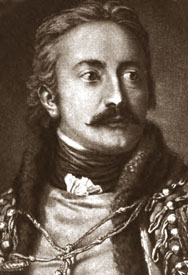(1765-1824) Saxon, Russian, and Prussian general. As a reward for his service in the Battle of Borodino, he was made a Saxon Freiherr (baron) on 8 October 1812. In spring 1813 he was commander of the important Saxon fortress at Torgau. In the combat at Wavre (18 June 1815) against superior French forces, the Prussian III Corps under his command secured the rear of Field Marshal Gebhard Fürst Blücher von Wahlstatt’s main forces, which were advancing toward Waterloo on the same day.
Thielmann entered military service in 1780 and became a corporal (7 June 1782); cornet (30 March 1784); second lieutenant (13 July 1791); premier lieutenant (3 May 1798); captain 2nd class (15 January 1807); captain (5 February 1807); major (1 March 1809); lieutenant colonel (12 April 1809); colonel (17 July 1809); major general (26 February 1810); and lieutenant general (12 May 1813). He entered Russian service as a lieutenant general on 19 March 1815 before transferring to Prussian service as a lieutenant general (the patent later being postdated to 10 June), which made him junior to generals Ernst Julius Freiherr Schuler von Senden, Karl Christian von Elsner, Levin Karl von Heister, Ludwig Mathias von Brauchitsch, and Friedrich Erhard von Roeder. His final promotion was to general of cavalry on 30 May 1824 (the patent being postdated to 31 May). During the French Revolutionary Wars, he served in the campaigns of 1793-1795. During the Napoleonic Wars he fought in the campaigns of 1806 in Saxony, 1807 in East Prussia, 1812 in Russia, and 1813- 1815 in Germany, France, and Belgium, respectively.
Born 27 April 1765, the son of a Saxon high official, Thielmann early on developed a love for the military and joined the Saxon cavalry at a young age, remaining in the line until 1806. Not being a nobleman, his advancement was slow. Nevertheless, his intelligence and abilities were recognized. After the Battle of Jena (14 October 1806), he was sent to French headquarters to discuss the terms of peace. Advancement followed, and on 1 April 1807, Thielmann became adjutant to General Georg Friedrich von Polenz, who commanded the Saxon auxiliary corps. On 15 June 1808, he became the Saxon military representative and adjutant to the French marshal Louis Nicolas Davout.
On 28 April 1809 Thielmann was made commander of the (weak) Saxon army corps defending Saxony against a corps of émigré Brunswick troops (the “Black Legion”) commanded by the Duke of Brunswick. On 26 February 1810, he became commander of a brigade of cuirassiers, which he also led to Russia in 1812, assigned to IV Reserve Cavalry Corps. His brigade distinguished itself at the Battle of Borodino (7 September 1812) but suffered extremely heavy losses, which were compounded by the ravages of the retreat from Moscow; only a handful of men returned with Thielmann to Saxony in December 1812. On 2 January 1813 Thielmann was made commander of the cavalry in Torgau, becoming governor of this fortress on 24 February. He resigned from Saxon service on 10 May, after his king decided to hand the fortress over to the French.
Entering Russian service on 1 September 1813, he was made leader of a raiding corps. On 26 October he was charged with the organization of a new Saxon army corps, which on 1 December formed the principal part of III Federal German Corps under the Duke of Saxe-Weimar. On 9 June 1814 Thielmann became commander of this corps.
During the Waterloo campaign, he was assigned command of III Corps of the Prussian army on 9 April 1815, and fought at Wavre, on the same day as the Battle of Waterloo. After the peace, he became commanding general in Westphalia on 3 October. On 3 April 1820 he was transferred as commander to VIII Corps. Thielmann died from a sudden stroke of apoplexy on 10 October 1824.
References and further reading Priesdorff, Kurt von. 1937-1942. Soldatisches Führertum [Military Leadership]. 10 vols. Vol. 3, pp. 458-466 (no. 1215). Hamburg: Hanseatische Verlagsanstalt.
